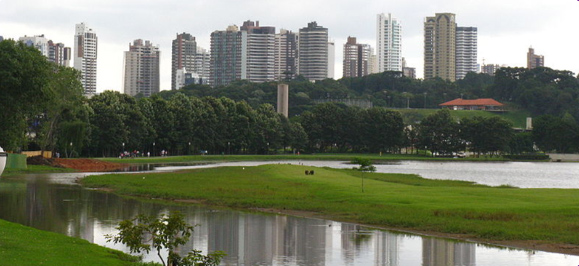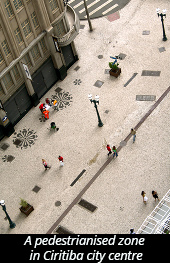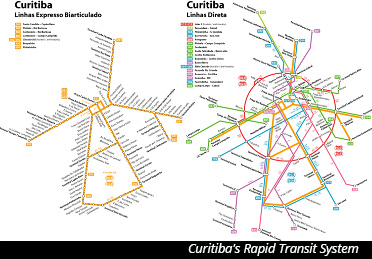Curitiba
Curitiba: A sustainable city in the developing world
Geographers love talking about sustainability! But what does it mean?
To be sustainable means to be able to keep going – for a long time. It seems like a simple idea, but when you are talking about things that use up material, space and energy (like a city), it may not be so easy after all...
How can you build a city for hundreds of thousands of people to live in without burning up energy, polluting the ground and the air and generally making a real mess of the place? Well, one city in Brazil seems to have the answer.

Curitaba, the state capital of an area of Brazil called Paraná, has been described as the most sustainable city in the world. Curitiba is largely a result of work by a man called Jaime Lerner.
40 years ago, when industry was growing quickly in Brazilian cities, Curitiba decided to do things differently. Firstly the city only allowed companies who were ‘non-polluters’ to move there. Then they built industrial areas with so much green space at first they were insulted as "golf courses" (until they became much more successful than anyone else!)
Over 30 years, Curitiba's earnings or domestic product grew faster than the rest of Brazil. Whatever they were doing – it was working!
So, what was working so well?
When the city planners built the city, they spent a lot of time thinking about the people who would be living there.
They built:
-
Health centres
-
Schools and a university
-
Day car networks
-
Neighbourhood libraries
-
Sports facilities


A pedestrianised zone in Ciritiba city centre
The planners made it easy for people to use these public (municipal) services by building ‘Citizenship Streets’. This meant building municipal facilities close to mass transportation terminals - in particular Curitiba’s remarkable bus system (see below).
After all – there is no point providing these great services if hardly anyone can get to them!
The city has an Open University (pictured above) so that residents can take courses in subjects like mechanics or hair styling. The Curitiba government are trying to provide work opportunities and a chance to earn more money for everyone in the city. They also want people to be able to own their own homes and have been buying large areas of land for people to build on.
Self-help – building a new kind of city
In Curitiba there is a Municipal Housing Fund to help lower-paid workers to build their own homes. The workers can meet an architect for an hour, for free, to help them develop their plans .
When a favela area is cleared, residents are moved into planned communities and get some building training and a small mortgage. This helps them to buy the land and materials for the house and build it themselves.
The workers new building skills can also help them to find better paid work. Slowly, informal workers from shanty towns are becoming home owners with a much better chance of having a steady job.
Jaime Lerner – Curitiba’s architect
By the 1960s, Curitiba's population had ballooned to 430,000. Architect Jaime Lerner, who later became mayor, led a team that suggested these ideas:
-
Strict controls on urban sprawl
-
Reduction of traffic in the downtown area
-
Preservation of Curitiba's Historic Sector
-
A convenient and affordable public transit system


He achieved these through pedestrianisation of large parts of the Central Business District, as well as a new road design to reduce traffic - the Trinary Road System
Five of these trinary roads form a star across the city centre. The bus rapid transport system carries more than 2 million passengers per day. Although there are lots of car owners in Curitiba, road traffic has dropped by 30%, and air pollution is the lowest in Brazil.
Brain box...
A big part of the success of Curitiba has come thanks to its carefully planned Trinary Road System and express buses.
Each road has two one-way lanes on the outside for normal traffic, and a two-way lane in the middle for the ‘bus rapid transit system‘. The buses are long and split into three sections. They have good disabled access and there is only one price no matter how far you travel.

The system is used by 85% of Curitiba's population and has been copied by cities all over Brazil and the rest of the world.
Curitiba – a green city
The city pays careful attention to its green areas and is called the ecological capital of Brazil. It has 28 parks and wooded areas and there is a massive there are 52 square meters of green space per person. (There was only 1 square meter of space per person back in 1970).

This ‘greenness’ has been made possible because:
-
1.5 million trees have been planted along the streets
-
Builders pay less tax if their projects include green space
-
Water is diverted into new lakes in parks (which also helps stop flooding)
-
Grass cutting in the parks has changed to sheep grazing which is a great sustainable use of green space!
Brain box...
A rubbish idea!
Curitiba’s ‘green exchange" programme helps people in need and the environment in several ways:
-
Families living in shanty towns which cannot be reached by bin lorries bring their rubbish to neighbourhood centres
-
Children can swap recyclable waste for school supplies, chocolate, toys and tickets for shows
-
This programme means less litter and less disease as well as a better life for the undernourished poor.
Under the ‘rubbish that's not rubbish’ programme (‘O Lixo que Não é Lixo’), 70% of the city's waste is recycled by its residents. Once a week, a truck collects paper, cardboard, metal, plastic and glass that has been sorted in the city's homes.
This saves trees and money raised from selling materials is used to help people in need like the homeless and recovering alcoholics and drug users.
Assessment for learning - Quiz
Before attempting this quiz, make sure that you have read all the articles in this issue:
-
Road to Rio – Part 1
-
Living in Rio
-
Curitiba
Pupil Activity
Design your own sustainable city (or school building)
-
Read carefully through this article.
-
Work in small groups and come up with ideas for a brand new city (or school building if you prefer). Think about:
-
Ways of saving energy
-
How to make the most of the available space
-
How to move people around quickly, easily and cheaply
-
What would you do to make sure that it is not only sustainable, but also a place that people want to be?
Put your ideas into a poster or PowerPoint presentation and share them with the class.


